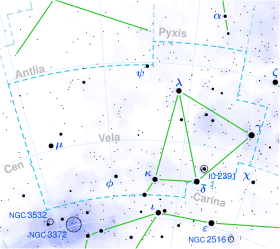| Observation data Epoch J2000 Equinox J2000 | |
|---|---|
| Constellation | Vela |
| Right ascension | 10h 46m 46.17877s[1] |
| Declination | –49° 25′ 12.9244″[1] |
| Apparent magnitude (V) | 2.69[2] (2.7 + 6.4)[3] |
| Characteristics | |
| Spectral type | G5III + G2V[3] |
| U−B color index | +0.57[2] |
| B−V color index | +0.90[2] |
| Astrometry | |
| Radial velocity (Rv) | +6.2[4] km/s |
| Proper motion (μ) | RA: +63.22[1] mas/yr Dec.: –54.21[1] mas/yr |
| Parallax (π) | 29.0506 ± 0.2991 mas[5] |
| Distance | 112 ± 1 ly (34.4 ± 0.4 pc) |
| Absolute magnitude (MV) | −0.06[6] |
| Orbit[7] | |
| Period (P) | 138 yr |
| Semi-major axis (a) | 1.427″ |
| Eccentricity (e) | 0.84 |
| Inclination (i) | 57.0° |
| Longitude of the node (Ω) | 59.1° |
| Periastron epoch (T) | 1951.1 |
| Argument of periastron (ω) (secondary) | 178.0° |
| Details | |
| μ Vel A | |
| Mass | 3.30[8] M☉ |
| Radius | 13[9] R☉ |
| Luminosity | 107[3] L☉ |
| Surface gravity (log g) | 2.75[8] cgs |
| Temperature | 5,047[8] K |
| Rotational velocity (v sin i) | 6.4[8] km/s |
| Age | 360[3] Myr |
| Other designations | |
| Database references | |
| SIMBAD | data |
Mu Velorum (μ Vel, μ Velorum) is a binary star system in the southern constellation Vela. The two stars orbit each other with a semi-major axis of 1.437 arcseconds and a period of 116.24 years.[11] (Wulff-Dieter Heintz (1986) lists a period of 138 years with his orbital elements.)[7] The pair have a combined apparent visual magnitude of 2.69,[2] making the system readily visible to the naked eye. From parallax measurements, the distance to this system is estimated to be 117 light-years (36 parsecs).[1] The system is about 360 million years old.[3]
The primary component is a giant star with an apparent magnitude of 2.7 and a stellar classification of G5 III.[3] It is radiating about 107 times the luminosity of the Sun from an expanded atmosphere about 13[9] times the Sun's radius. The mass of this star is 3.3[8] times that of the Sun. In 1998, the Extreme Ultraviolet Explorer space telescope detected a strong flare that released an X-ray emission nearly equal to the output of the entire star. The quiescent X-ray luminosity of Mu Velorum A is about 1.7 × 1030 erg s−1.[3]
The fainter companion, Mu Velorum B, is a main sequence star with an apparent magnitude of 6.4[3] and an assigned stellar classification of G2V.[3] However, this classification is suspect. Closer examination of the spectrum suggests the star may actually have a classification of F4V or F5V, which suggests a mass of about 1.5 times the mass of the Sun. Such stars typically do not show a marked level of magnetic activity.[3]
- ^ a b c d e Cite error: The named reference
aaa474_2_653was invoked but never defined (see the help page). - ^ a b c d Cite error: The named reference
clpl4_99was invoked but never defined (see the help page). - ^ a b c d e f g h i j Cite error: The named reference
apj526_1_445was invoked but never defined (see the help page). - ^ Cite error: The named reference
rgcrvwas invoked but never defined (see the help page). - ^ Brown, A. G. A.; et al. (Gaia collaboration) (2021). "Gaia Early Data Release 3: Summary of the contents and survey properties". Astronomy & Astrophysics. 649: A1. arXiv:2012.01533. Bibcode:2021A&A...649A...1G. doi:10.1051/0004-6361/202039657. S2CID 227254300. (Erratum: doi:10.1051/0004-6361/202039657e). Gaia EDR3 record for this source at VizieR.
- ^ Cite error: The named reference
Cardini2005was invoked but never defined (see the help page). - ^ a b Cite error: The named reference
aass64_1_1was invoked but never defined (see the help page). - ^ a b c d e Cite error: The named reference
aaa409_251was invoked but never defined (see the help page). - ^ a b Cite error: The named reference
apjss164_1_173was invoked but never defined (see the help page). - ^ Cite error: The named reference
SIMBADwas invoked but never defined (see the help page). - ^ Cite error: The named reference
bsc1987was invoked but never defined (see the help page).
